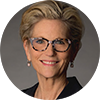Download PDF

Back in May, I wrote an Opinion titled “Reflections During a Crisis,” a piece that seems almost quaint today. At that time, most of us didn’t yet realize that the unfolding COVID-19 pandemic would last well beyond a few weeks or months. We had yet to experience the protests and riots that followed the death of George Floyd and our dismay at the dozens of people who sustained ocular injury from rubber bullets. But now we approach the end of a year most of us are glad to get behind us.
Much has been written about the tragedies, the economic effects, the health crises, and the emotional toll of this year. Recently, a friend asked a surprising question: What are the hidden gifts of the pandemic? It didn’t take long to think of a few examples.
While closing our practices in March, as recommended by the Academy, we were doing our part to “flatten the curve.” In retrospect, we were also undergoing an abrupt reset. The process of opening back up in the midst of an unfolding pandemic required a reimagining of how we see patients, and every single step was analyzed.
Although many of the adaptations we’ve made will fall away once the pandemic is mitigated, a few changes should be permanent. First, can we eliminate the concept of a waiting room? Most practices streamlined patient flow to limit wait times and keep the waiting room mostly empty. What an opportunity to continue to refine the process of patient flow! Why can’t we get so efficient that the patient experience is more like, say, an Apple store? Second, in order to distance our patients, many ophthalmologists extended their patient hours, opening at 7 a.m., closing late, or offering Saturday hours. What if we permanently provided exam times that accommodated the complicated schedules of modern life?
Ophthalmologists also learned new skills. While telemedicine hasn’t replaced the in-person exam, we tried out several platforms and shared ideas about how telemedicine might become part of the patient care model. Could some urgent visits be triaged using telehealth? Could one post-op visit after cataract surgery be a telehealth visit? These ideas will continue to percolate. With our colleagues, we learned how to videoconference as Zoom morphed from a noun into a verb. I recently met for two hours with the residents in a city 1,000 miles away, and we had a vigorous and meaningful discussion about cases, ethics, leadership skills, and life. Our newfound comfort with videoconferencing can increase interactions between colleagues, and training programs can more easily and efficiently invite faculty to interact with residents and fellows.
Though millions of Americans lost their jobs and their health insurance, most ophthalmology practices have been able to retain staff. We provide steady, secure employment with great benefits for families in our communities, which is a service on par with the value we bring our patients. The jolting events of 2020 have also spurred conversations—and, more importantly, action—about diversity and inclusion. Organizations and individuals are beginning to do the very hard work of recognizing unconscious bias, listening to colleagues and employees, and cultivating collaborative processes to promote equity in the workplace. This commitment will continue, I hope, long after 2020 is a memory.
I just finished reading Camus’ The Plague. The protagonist, Dr. Bernard Rieux, is a young, philosophical doctor who devotes himself to treating patients dying from the bubonic plague. Rieux sums up the commitment of a physician when he says, “I have no idea what’s awaiting me, or what will happen when this all ends. For the moment I know this: there are sick people and they need curing.” Perhaps the most meaningful hidden gift of 2020 is that despite a pandemic that is crippling economies and many businesses, most ophthalmologists have returned to near-normal volumes, and we are keeping our patients and our staff safe. I’m incredibly grateful that I can continue to see my patients—and that they can continue to get ophthalmic care.